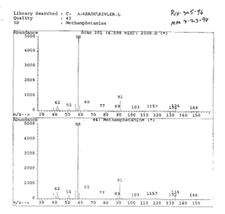Clandestine Methamphetamine Manufacture; Part I
DIVERSION OF OVER-THE-COUNTER DECONGESTANT TABLETS
FROM DRUG STORE TO CLANDESTINE LABORATORY: A QUANTITATIVE
ANALYSIS FOR METHAMPHETAMINE AND RELATED COMPOUNDS
[ISBN 0-9621181-2-5]
$21.95 (US)
(33 Pages of Text + 17 Exhibits)
 Manufacture of Methamphetamine in California constitutes a violation of Health & Safety Code Section 11379.6(a), to wit a felony. The reduction of precursors ephedrine or pseudoephedrine in the presence of hydriodic acid , to methamphetamine, constitutes a relatively simple and inexpensive means of production (yields typically 50-80%) of methamphetamine by the amateur chemist. Manufacture of Methamphetamine in California constitutes a violation of Health & Safety Code Section 11379.6(a), to wit a felony. The reduction of precursors ephedrine or pseudoephedrine in the presence of hydriodic acid , to methamphetamine, constitutes a relatively simple and inexpensive means of production (yields typically 50-80%) of methamphetamine by the amateur chemist.
Prior to the passage of the federal Comprehensive Methamphetamine Control Act of 1996 supplies of the OTC decongestant Pseudoephedrine were virtually unlimited and available to anyone. Thus for the cost ($5.00 or less) of approximately ten, 120 mg pseudoephedrine tablets (or approximately one gram bulk pseudoephedrine) and a few other chemical ingredients, a methamphetamine chemist or “cook” could produce one gram of methamphetamine with a street value of $200.00.
For the purpose of manufacturing pure methamphetamine it is obviously preferable to obtain pure precursor in bulk quantity in order to eliminate the formation of side products and impurities formed during the manufacturing process. However once Congress closed the loophole by prohibiting mailorder and drugstore purchases of large quantities of ephedrine and pseudoephedrine, potential criminals sought to acquire the precursor in whatever form they could get it.
Pseudoephedrine as an active ingredient is present alone or in combination in many OTC products; this e-Report describes the details of a real life case in which there occurred an alleged theft from a supermarket of a large variety of decongestant tablets containing a mixture of active ingredients. These allegedly stolen tablets were subsequently traced by law enforcement officials who found them dissolved in a chemical reaction mixture solution and subsequently seized them as evidence.
The use of tablets containing mixtures of active ingredients significantly complicates a forensic chemical analysis for the presence of methamphetamine which is required in order for the prosecution to obtain a conviction for the offense at issue. Liquids that are seized as evidence are suspected by law enforcement of containing methamphetamine and dissolved tablets comprised of mixtures of active ingredient precursors; however these suspicions must be proven beyond a reasonable doubt. This e-Report provides an actual Gas Chromatography-Mass Spectrometry quantitative analysis of chemical products detected in liquid samples seized by law enforcement.
CONTENTS
I. Analytical Results
A. Physical-Chemical Characteristics
1. Two-Phase System
2. Mixed Phase System
B. Gas Chromatography-Mass Spectrometry Analysis of Underivatized Samples
1. Extraction Procedure
2. Chromatographic Conditions
3. Mixed Calibration Run
4. Results for upper phase, lower phase and precipitates
C. Quantitative GCMS: Measurement of Concentration of Controlled Substances
1. Quantitation using Internal Standards
2. Derivatization of Standards and Unknowns
3. Selective Ion Monitoring
4. Quantitation of Pseudoephedrine in Forensic Samples
5. Quantitation of Ephedrine in Forensic Samples
6. Quantitation of Methamphetamine in Forensic Samples
7. Quantitation of Amphetamine in Forensic Samples
8. Quantitation of Phenylpropanolamine in Forensic Samples
$21.95 (US)
|
|